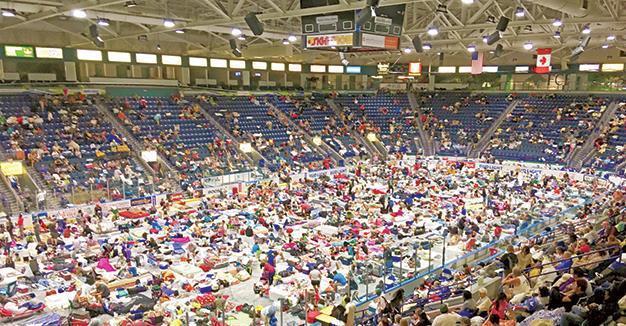Regaining force, Irma lashes Florida with powerful winds
MIAMI – Agence France-Presse
 Hurricane Irma regained strength on Sept. 10 as it began pummeling Florida, threateningalmost the entire southeastern U.S. state after cutting a deadly path of destruction through the Caribbean.
Hurricane Irma regained strength on Sept. 10 as it began pummeling Florida, threateningalmost the entire southeastern U.S. state after cutting a deadly path of destruction through the Caribbean.The storm, packing of winds of 210 kph, was upgraded to a Category 4 storm as it closed in on the island chain known as the Florida Keys, the U.S. National Hurricane Center said.
Tens of thousands of Floridians were hunkering down in shelters for a direct hit from the monster storm.
More than 6.3 million -- nearly a third of the state’s population -- were ordered to evacuate.
For those still at home, it was already too late to escape the wrath of what could be the worst hurricane in storm-prone Florida.
“If you have been ordered to evacuate anywhere in the state, you need to leave right now. Not tonight. Not in an hour. Now. You are running out of time to make a decision,” Governor Rick Scott said hours before wind gusts began to lash the Keys.
Florida Power and Light said more than 170,000 homes and businesses in the state had lost power, as the storm churned about 115 kilometers south-southeast of Key West.
Its eye was expected to cross the Lower Florida Keys within hours before moving “near or along” the peninsular state’s west coast, where it threatened storm surges of up to 4.5 meters -- enough to cover a house.
At North Collier Regional Park, a designated shelter just outside the city of Naples, anxious evacuees prayed they and their loved ones would remain safe when the storm made landfall. “All we wanted to make sure is to feel safe and whatever happens we just have to start I guess from the beginning,” Viviana Sierra said.
MacDill Air Force Base, the military installation home to U.S. Central Command, issued mandatory evacuation orders with the eye of the storm expected to pass near or over its home city of Tampa early Monday. The Kennedy Space Center was also closed.
At least 25 people have been killed since Irma began its devastating march through the Caribbean earlier this week.
Terrified Cubans who rode out Irma in coastal towns -- after the storm made landfall Sept. 8 as a maximum-strength Category 5 storm on the Camaguey archipelago -- reported “deafening” winds, uprooted trees and power lines, and blown rooftops.
There were no immediate reports of casualties, but officials reported “significant damage.” A total of 1.5 million people were evacuated.
Authorities in Havana were evacuating people from low-lying districts at risk from Atlantic storm surges.
Enormous waves lashed the Malecon, the capital’s emblematic seafront, causing seawaters to penetrate some 250 meters into the capital.
In Florida, cities on both the east and west coasts took on the appearance of ghost towns, as nervous residents heeded insistent evacuation orders.
The storm was expected to move along or near Florida’s southwest Gulf coast by yesterday afternoon.
But Irma is so wide that authorities were bracing for destructive storm surges on both coasts and the Keys.
On highway 75 along the western coast of Florida, a steady stream of cars pressed northward as thousands fled at the last minute.
Strip malls, fast food restaurants and retail giants were all closed for business.
In Key West, police had opened a “shelter of last resort” for those who had ignored mandatory evacuation orders.
Warning that Irma would be worse than Hurricane Andrew -- which killed 65 people in 1992 -- Scott, Florida’s governor, said all 20.6 million Floridians should prepare to flee.
















